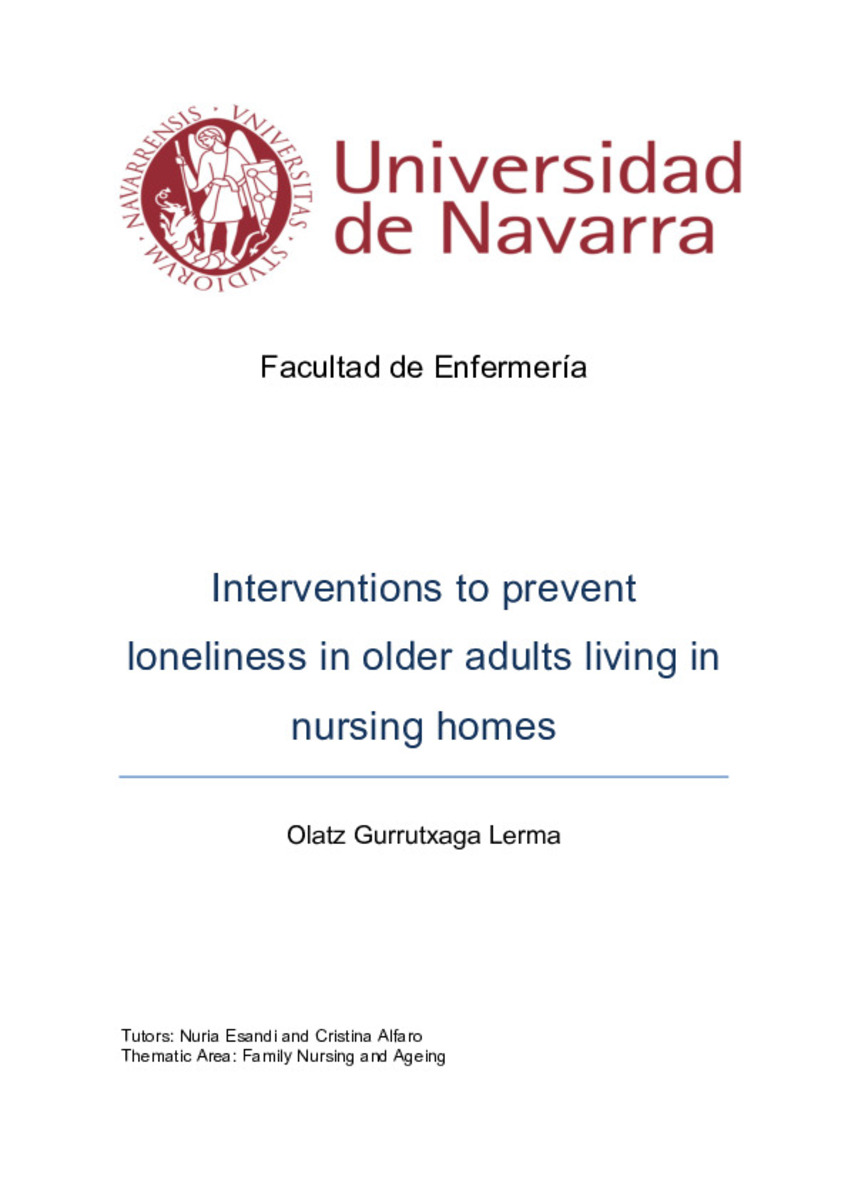Full metadata record
| DC Field | Value | Language |
|---|---|---|
| dc.contributor.advisor | Esandi, N. (Nuria) | - |
| dc.contributor.advisor | Alfaro-Díaz, C. (Cristina) | - |
| dc.creator | Gurrutxaga-Lerma, O. (Olatz) | - |
| dc.date.accessioned | 2021-12-15T12:58:23Z | - |
| dc.date.available | 2021-12-15T12:58:23Z | - |
| dc.date.issued | 2021 | - |
| dc.date.submitted | 2021 | - |
| dc.identifier.uri | https://hdl.handle.net/10171/62658 | - |
| dc.description.abstract | Introduction: The number of older adults is increasing worldwide, as a result their need for institutionalized care is rising. One of the problems older adults experience when going to a nursing home is loneliness. Loneliness affects the person quality of life, so it is vital to help prevent it with appropriate interventions. Objective: To explore the different kind of interventions to prevent loneliness of older adults living in nursing homes. Methodology: This systematic review used three databases (PubMed, CINAHL, and PsycInfo) and searched for articles from 2010 to 2020 using search terms like “older adults”, “prevent”, “loneliness”, and “intervention”. From an initial 124 articles, 16 articles were selected at the end. Results: Two main themes were found: person-to-person/group interventions and technological interventions. All interventions showed positive results in reducing the perception of loneliness. Group interventions showed high success on reduction of loneliness. For technological intervention, the use of a pet robot created an atmosphere where residents socialize. Videoconferencing and messaging showed the need of a third party implication. Conclusion: Interventions found in this review are an effective way of alleviating loneliness even if interventions were vaguely described, and there was not follow up for long-term effectiveness. | es_ES |
| dc.description.abstract | Introducción: El número de personas mayores está incrementando en todo el mundo, por lo que la necesidad de cuidados para personas institucionalizadas aumentará. Uno de los problemas que las personas mayores experimentan cuando van a una residencia es la soledad. La soledad afecta a la calidad de vida de las personas, por lo que es importante prevenirla mediante intervenciones apropiadas. Objetivo: Presentar diferentes tipos de intervenciones para prevenir la soledad en personas mayores institucionalizadas. Material y métodos: Está revisión utilizó tres bases de datos (PubMed, CINAHL y PsycInfo) y se buscaron artículos entre los años 2010-2020. Se utilizaron términos cómo “older adults”, “prevent”, “loneliness” y “intervention”. De una selección inicial de 124 artículos, se seleccionaron 16 artículos. Resultados: Se encontraron dos temas principales: intervenciones entre personas o grupos de personas e intervenciones tecnológicas. Todas las intervenciones mostraron resultados positivos. Las intervenciones grupales mostraron una gran efectividad. Las intervenciones de videoconferencias y mensajes necesitaban a una tercera personas para poder llevarse a cabo. Las relacionadas con el robot Paro creaban una atmósfera donde los residentes les resultaba más fácil interaccionar. Conclusiones: Las intervenciones fueron efectivas para aliviar la soledad, a pesar de descripciones imprecisas de las intervenciones y la falta de seguimiento a largo plazo. | es_ES |
| dc.language.iso | eng | es_ES |
| dc.rights | info:eu-repo/semantics/openAccess | es_ES |
| dc.subject | Materias Investigacion::Ciencias de la Salud::Enfermería | es_ES |
| dc.subject | Loneliness | es_ES |
| dc.subject | Older adults | es_ES |
| dc.subject | Nursing home | es_ES |
| dc.subject | Intervention | es_ES |
| dc.subject | Prevent | es_ES |
| dc.subject | Soledad | es_ES |
| dc.subject | Personas mayores | es_ES |
| dc.subject | Intervención | es_ES |
| dc.subject | Prevenir | es_ES |
| dc.subject | Residencia | es_ES |
| dc.title | Interventions to prevent loneliness in older adults living in nursing homes | es_ES |
| dc.type | info:eu-repo/semantics/bachelorThesis | es_ES |
Files in This Item:
Statistics and impact
Items in Dadun are protected by copyright, with all rights reserved, unless otherwise indicated.






